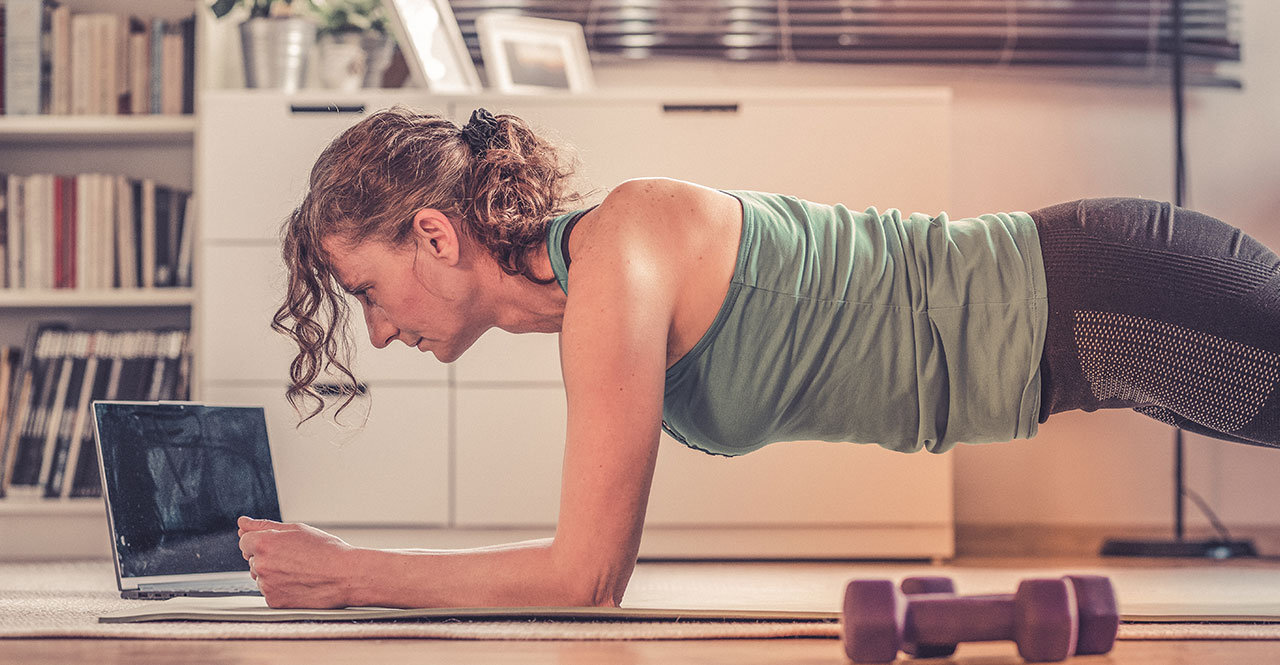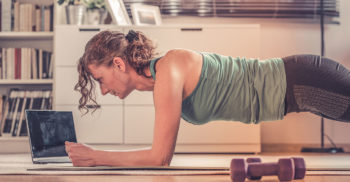 Reading Time: 6 minutes
Reading Time: 6 minutesThere are a lot of reasons people abandon their gym. For some it’s the cost, others it’s the “scene,” and for others, the gym experience is too sterile and limiting.
These days, your gym may have abandoned you, but that doesn’t mean you can’t get a world-class workout with just a few basic principles using an at-home minimalist training style.
These tips and tricks have helped people train anywhere in the world with little to no equipment — and they can help you, too.
The Whole Life Challenge will help you stick to a basic daily exercise habit whether you have a gym membership or not. These strategies can help ensure you have what you need to fulfill your daily exercise needs and create a habit of fitness that supports your health and your lifestyle.
Are you ready to never need a gym membership again? Do you want to know how to train anywhere from your living room to a sunny beach to a snowed-in hotel room? If you’re looking to stay fit no matter the circumstances and take your fitness into your own hands, then let’s get started!
Step 1: Do Bodyweight Exercise
If there’s one thing you can do, above all else, that allows you to take your training anywhere, it’s learning how to use your own bodyweight. Building a knowledge of basic bodyweight exercises and their logical progressions goes a long way toward having a virtual gym with you everywhere you go.
If you have a knowledge of basics such as push-ups, chin-ups, rows, squats, lunges, and core exercises (like sit ups and planks), you can get a world-class workout anywhere in the world.
For each exercise, you should also learn at least three to four ways to make it harder or easier, allowing you to increase or decrease the “weight” of the exercise.
For example:
- Push ups—if you can easily do 10 or 20 push ups, elevating your feet on a chair will make them harder. If you’re still working your way up to 10, elevating your upper body on that same chair or dropping to your knees will lighten your load.
- Squats—A basic squat starts with your feet at hip width, dropping your butt below your knees. If you want to increase the difficulty, hold something heavy or jump at the top of each squat. If you’re still working on your squat, placing your hand on something for balance, placing a 1” lift below your heels, or only going to the depth that challenges you are places to start
- Core—From basic crunches to bicycles to planks, there are innumerable ways to scale core exercises to your level. If you’re not at the point yet where you can easily sit up, then assist yourself to sitting and lower yourself as slowly as you can back to the lying position of your sit-up.
With a basic set of exercise and a couple of adaptations you’ll be well on your way to developing the knowledge of how to use your own body as your gym.
There are lots of resources available to help you develop an understanding of bodyweight training and their scaling options. You could find a highly qualified fitness coach to help you, or you could look to YouTube channels, books, videos, and blogs. The Whole Life Challenge 6-Week Workout Plan is a great resource not just for its programming, but for a complete video library with movement and scaling instructions.
Step 2: Buy some essentials
If you know you won’t have gym access, long term or short term, put together a collection of fitness essentials. The essentials aren’t heavy and they store or carry easily in a small bag. You can use them at home, at the park, or on the road. Here are some basics:
- 1 suspension trainer (TRX, gymnastics rings, Lifeline Jungle Gym, etc.)
- 1 jump rope
- 1-2 resistance bands
- 1 lacrosse ball
The suspension trainer allows you to perform unlimited versions of bodyweight exercises. Its inherent instability gives you an automatic “harder” version of almost any bodyweight exercise.
A jump rope is a lightweight, portable, and effective conditioning tool that can be used in small spaces or outdoors. If you don’t like to run, you can get the same kind of conditioning (and more) staying in the same spot with a jump rope. More than that, you’ll build agility and coordination.
Basic resistance bands can be used for stretching, mobility, and strength training. They offer a kind of “weighted” resistance you can get from dumbbells or barbells, but also help you get into stretching and mobility positions that you otherwise may not be able to achieve due to your current level of mobility.
Finally, the lacrosse ball is great for those tight areas that require self-massage. When a workout is over (or when you don’t really feel like doing a workout at all), a lacrosse ball is a great tool for working out knots and tight muscles. Exercise routines aren’t all about building muscle. They can be just as much about taking care of your body as well.
Like the book says, we’re born to run. Our bodies are built to move and our feet can do a lot when it comes to fitness. Not only is running a great workout, it’ll build your legs, and you can do it just about anywhere. If you can’t run (or don’t want to), even walking at a brisk pace on a daily basis is a solid part of a fit lifestyle.
If you can get to the great outdoors, nature adds different dimensions to running and walking. A sandy beach will up the intensity and a hiking trail with its varied surface can make things both easier on your joints (city surfaces don’t vary significantly, meaning each step hits you in the exact same spot) increase the opportunity for practicing balance.
We’ve known people who have completely changed their life using the Whole Life Challenge just by committing to a daily practice of running. The no-nonsense simplicity of it provides the freedom and flexibility to adapt it to your changing needs and keep building a daily habit.
Now you might think that running means doing the same thing every day. It doesn’t! If you need some help designing a workout program that works for you, check out How to Design You Own Workout Program: A Guide For Beginners for pro-tips on making planning easy!
All in all, walking and running offers a lot to your routine, especially if you get creative and combine your runs with bodyweight exercises!
Step 4: When all else fails, play!
Sometimes a routine workout isn’t what any of us wants to do. That’s fine, too. There is a time when the best thing you can do is play!
All of the workouts that we do are great for endurance, strength, and other aspects of fitness, but if there’s anything our bodies are good for, it’s playing. Training with programmed routines offers a very predictable sort of exercise. Playing has the added benefit of the unpredictable. Our bodies respond differently when we’re forced to observe and adapt at a moment’s notice.
Whether that’s rasslin’ with your kids, chasing your dog (or even better, chickens!), or playing sports, adding playtime into your routine not only keeps things fun, it adds an extra dimension to your training that standard movements can’t.
Whether it’s a recreational league or just a pickup game of paddleball, basketball, soccer, or disc golf (some of those courses are hilly!), sport can be one of the highest forms of physical fitness training.
Breaking free of gym life
By learning how to use your body as your gym, stocking up on a few lightweight essentials, dusting off your running shoes, and finding ways to have a little fun can go a long way to filling in the gaps left by losing your gym.
Even with a gym, these 4 strategies can add freedom and flexibility to your fitness life, which can help break you free from any and all reasons not to exercise! It’s truly a freeing experience.
The Whole Life Challenge gives you the structure and support you need to be able to put exercise and other habits into practice every day in small, simple, and effective ways. Join now and build the habits you need to manage daily stress and uncertainty and build health, well-being, and resilience for the future.







